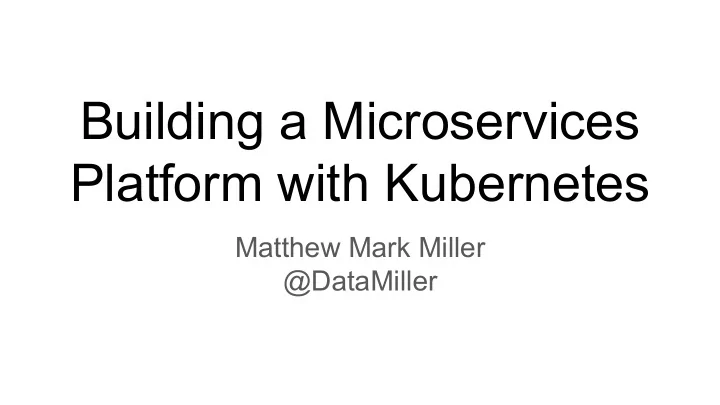

Building a Microservices Platform with Kubernetes Matthew Mark Miller @DataMiller
Cloud Native: Microservices running inside Containers on top of Platforms on any infrastructure
Microservice A software component of a system that is independently releasable and independently scalable from other parts of the system.
Container A software process whose access has been reduced to the point that it thinks it is the only thing running.
Platform The parts of your service that you don't build yourself.
But wait...aren’t we supposed to be Full Stack?!
A platform’s responsibility is to make implicit the link between a service and the resource it consumes.
Clouds operate because of workload orchestration
Don’t roll your own orchestration.
Integrating workloads requires tinkering at runtime Token swapping Modifications to the host container’s configuration Swapping in binaries
Integrating this way isn’t easy Takes time & testing to get it right What you built and tested isn’t necessarily what runs in production. Leads to providers offering fewer, more highly opinionated stacks
A big question for platform engineers: How can we spend more time building useful services and less time maintaining the platform?
Kubernetes Borg meets Docker; Resistance is futile
(Obligatory architecture slide)
Kubernetes is popular, open and growing
To those of us building platforms, Kubernetes offers Reliable cluster & workload management A stack agnostic hosting abstraction (Docker) Battle-tested fundamental abstractions that give rise to powerful deployment patterns
Kubernetes Fundamentals
Controllers Loops that maintain state Run continuously on Master Each Kubernetes object gets its own Controller Controllers are pluggable & lightweight Rely on declarative manifests to determine intent
The Pod Many containers, working together as a single unit Shared IP & localhost Shared filesystem Scale together Separate hardware limits Can be tagged with a label , providing scheduling advice
Services Permanent, logical addresses for internal services Expose a name, port and stable IP for a group of pods Load balance between individual pods Provided to pods via DNS or environment variable Constructed using a selector onto pod labels ( sort of like a database query)
Networking Rules for all Kubernetes installations Each Pod gets its own unique IP address (which is the same outside and in) All Pods must be able to communicate with each other without NAT All Pods must be able to communicate with and participate in Services
Ingress Simplifies Layer 7 access to Kubernetes services Works with load balancers, including cloud load balancers & nginx Presents a single root URL mapping to multiple services Publicly expose private networks Terminates TLS/SSL
Using the fundamentals to build a platform Pod patterns from Burns & Oppenheimer, USENIX 2016
How can my platform provide availability during workload releases?
Rolling Deployments
Rolling Deployments
Rolling Deployments
Rolling Deployments
How can my platform non-destructively add functionality to a workload?
Sidecars
How can my platform insulate workloads from complexity and state of services?
Ambassador
How can my platform communicate with a workload when I want a different protocol than it was built with?
Adapter
How can my platform provide “singleton” behaviors in a scaled-out service?
Leader Elector
How can my platform provide “work queue” behavior without altering a workload?
Work Queue
Kubernetes Tweet Bait “Could this be POSIX of distributed systems?!”
How does it all come together?
Scalewhale: A troubled service The output we want… … but we get overloaded
Initial rollout
Brute force scale-out
Metric-driven Autoscale
Swap in a work queue!
Questions
Get hip to the heptagon A platform is a real developer advantage but must avoid reinvention and being overly proscriptive. Kubernetes was built to bring independence from hardware choices. Kubernetes also brings separation of concerns to dev teams. It’s built from simple rules and objects that improve the usefulness and portability of containers.
Slides available at https://is.gd/k8splatform
Bibliography “Design Patterns for Container-base Distributed Systems” -- Burns, Oppenheimer USENIX 2016 “Site Reliability Engineering” -- Beyer, Jones, Petoff, Murphy. O’Reilly 2016 “From Google to the World: The Kubernetes Origin Story” -- McLuckie, 2016
Recommend
More recommend